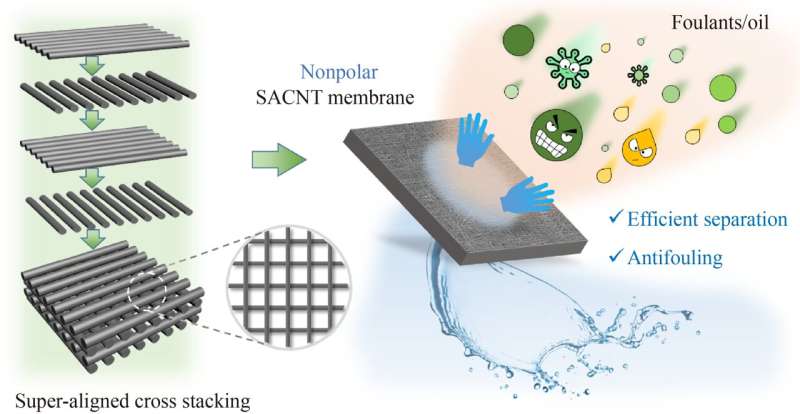This article has been reviewed according to Science X's editorial process and policies. Editors have highlighted the following attributes while ensuring the content's credibility:
fact-checked
proofread
An innovative strategy for efficient wastewater treatment: Cross-stacked super-aligned carbon nanotube membranes

Membrane separation technology has been widely recognized as a more advantageous technology owing to its high treatment efficiency, low footprint, reliable effluent quality. However, its further sustainable growth has been hampered due to membrane fouling. Although great efforts have been made in the recent decades to improve the antifouling performance via various modification strategies, but the obtained membranes commonly possess more complicated surface chemistry, which is unfavorable for membrane fouling control.
The polarity of molecules essentially determines their molecular interaction behavior. Nonpolar membranes may exhibit advantages in antifouling because the electric dipole moment is close to zero, which is not conducive to the deposition of pollutants on the membrane surface. However, such a fundamental interaction mechanism is rarely considered in the previous membrane fabrication and modification studies.
Also, nonpolar materials have not been sufficiently concerned in previous membrane preparation studies. Although carbon nanotube had been increasingly employed for membrane fabrication, the potential beneficial effects of its nonpolar feature had been barely investigated. A few studies developed vertically aligned CNT membranes, but they are not suitable for micro-/ultra-filtration processes due to limited pore size and porosity.
To address these barriers, researchers from Beijing Forestry University and Tsinghua University prepared a nonpolar super-aligned CNT (SACNT) membrane with a layer-by-layer cross-tacking strategy. Their study reveals that SACNT membrane surface chemistry is simple and inert, potentially eliminating covalent bonding induced membrane fouling.
Besides, compared with the commercial membranes, the SACNT membranes obtained a significantly higher selectivity while achieving a comparable or higher permeability This study entitled "Nonpolar cross-stacked super-aligned carbon nanotube membrane for efficient wastewater treatment" is published online in Frontiers of Environmental Science & Engineering in 2023.
In this study, the research team found that the surface chemistry of the SACNT membranes is simple and inert, thereby potentially eliminating the covalent-bonding-induced membrane fouling. Besides, the SACNT membranes exhibited a typical nonpolar wetting behavior, with high contact angles for polar liquids (water: ~124.9°–126.5°; formamide: ~80.0°–83.9°) but low contact angles for nonpolar diiodomethane (~18.8°–20.9°). Their research achieved a smoother and more uniform structure with higher permeability than commercial membranes. The SACNT membrane in municipal wastewater treatment cleaning efficiency increased by 2.3 times, oil/water separation efficiency reached 99.2%.
This study successfully proposed a novel nonpolar SACNT membrane by using a layer-by-layer cross-stacking method using the nonpolar carbon nanotubes as the raw material. This work not only provides a new solution to the problem of membrane pollution in membrane separation technology, but also improves the efficiency of municipal sewage treatment and waste water recovery, which has a broad application prospect in various fields.
More information: Shuang Zhang et al, Nonpolar cross-stacked super-aligned carbon nanotube membrane for efficient wastewater treatment, Frontiers of Environmental Science & Engineering (2022). DOI: 10.1007/s11783-023-1630-3
Provided by Higher Education Press




















